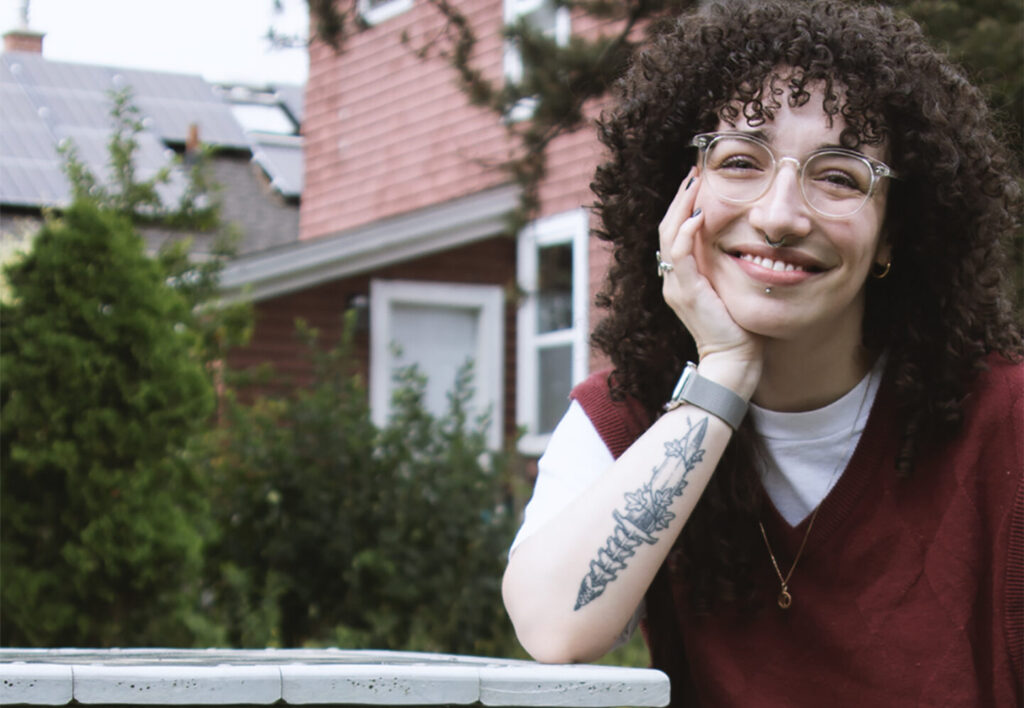Welcome back to Real Talk with Rachele, where we discuss all things disabled sex! This month we’re talking about safer sex practices.
I think for a lot of people, safer sex practices equate to condoms and trying to avoid infections or unplanned pregnancies. But for me, and for a lot of disabled folks, safer sex is more than that. It’s about all elements of safety – emotional, psychological, and physical – and tends to be a lot more nuanced than just “wrapping it up”.
For me, safer sex is about knowing your options, communicating with partners, and planning for difficult situations. How will you know what barrier methods are available to you? Where can you get tested for STIs? What other physical safety precautions do you need to take for your body? Do you feel comfortable discussing these things with a partner? Hopefully, we’ll answer some of these questions in today’s post.
Knowing your body and your options
Figuring out what sort of safety precautions you are going to take starts with knowing what you want to protect against and what options exist for your body. Barrier methods – like condoms, internal condoms, dental dams, and gloves – are great for protecting against pregnancies AND sexually transmitted infections (STIs), whereas other birth control options – like the pill, implants and IUDs (intrauterine devices) – only protect against pregnancies.
It’s also important to consider other aspects of your physical health. Sex can involve way more than just genital contact. What limits does your body have when it comes to movement? What types of movements lead to pain you might want to avoid? What other aspects of your health are you considering? Are you trying to protect yourself from COVID or other viruses spread through air or kissing? Do you need to think about your blood pressure or blood sugar? When you are finished with your sexy experience, are your mobility devices within reach?
Planning ahead is important for safer sex practices but also makes whatever sexual experience you are having more accessible and more fun when you don’t have to worry about what might happen.
Testing procedures
STI testing is not just for when you have symptoms, it’s a great harm reduction approach since many infections (and other viruses) can be asymptomatic. If you’ve never gotten tested before, but have had any sort of sexual encounter, a full STI workup is a good place to start. Find out where you can get tested and for which infections. A walk-in clinic might be able to offer you a swab test, but that will only test for a few STIs. Blood work and urine samples are necessary for others, so it’s important to ask for those things at your appointment.
Some cities have STI testing clinics and sexual health centres, and those are usually the best places to go if you can because they are set up to navigate this specifically. But not every city has these, and even a sexual health centre can make assumptions about your body or what tests you might need and make a mistake.
A really useful tool for figuring out which STIs you should be screened for is Check Me Out, an initiative created by Health Equity Alliance of Nova Scotia. They created a form to help people figure out what STIs they should be screened for based on the way they answer, and you get a checklist to guide you when you’re done. You can find it here: https://checkmeout.ca/checklist/
Talking about safer sex practices
Once you’ve figured out your safer sex options and desires, you need to be able to discuss them with a partner! Whether it’s to share your results or inquire about theirs, plan for what safety precautions you will enlist when you are having sex, or even to offer to get tested together.
When starting the conversation, it’s important to consider how you are wording things. As much as I wish there was less stigma surrounding STIs, I know that as a society, we are not quite there yet. Coming right out with “have you been tested recently?” can feel a little intense and judgemental, so I like to start with offering information. Something like “I was last tested 6 months ago for gonorrhea and chlamydia, but I would like to do a full STI screen before we have sex. Would you want to do that together?”. This type of offer shows that I am generally proactive about my own safety, while also considering the other person, without it feeling like I’m asking them to do something because I have made an assumption about them. Similarly, with barriers I might say something like “I usually use this brand/style of condom/dental dam/lube, do you have a preference?”. Offering information and asking for information in a way that states my boundaries but offers collaboration.
The other conversation you probably want to be having is about your emotional and physical safety outside of STIs. Discussing your desires and boundaries is both the way to have good sex AND a safety precaution. Help your partner understand what activities you want to do and what you are not interested in, what you like and what your hard ‘no’s are going to be. Body parts you want to engage with and body parts you don’t. And make sure you are learning these things about your partner too! All of these are going to be important for having the kind of sex you both want while also keeping you and the other person safe.
Aftercare
The last piece of the puzzle here is what happens after sex. Aftercare is a common phrase used in kink and BDSM communities to refer to the “comedown” process, or what people do to return to their neutral state. Anytime our bodies go through somethings intense, whether physically or emotionally, we need time to adjust to get back to our neutral. But a lot of people skip this step when it comes to sex that isn’t considered kinky.
Since becoming disabled, I have put a lot more thought and effort into my aftercare process simply because I have to. My body needs adjustment time after any activities that affect my heart rate, body position, emotional state, and sensory experiences.
So whether it’s getting my body back into a comfortable, neutral state, getting cleaned up, or attending to any emotional or health needs, the aftercare process is necessary for me to leave a sexual situation feeling positive, instead of leaving with a yucky feeling that is likely to sour the whole experience.
Aftercare practices are something I communicate about with a partner ahead of time. It’s one of the many things on my list that tells me if a potential partner is going to be a good match for me. This is something we can easily fit into our safer sex talk, on top of sharing our desires and things we’re interested in doing in the first place.
And if you run into conflicting needs or expectations when it comes to aftercare, sometimes there are ways to work around them. For example, if you like to cuddle and chat but the other person wants some alone time to be silent, there may be a middle ground (like cuddling silently). But if your aftercare needs don’t match up at all – if you need help getting cleaned up and back into a mobility device, but the potential partner wants to rush out the second they determine sex to be “over” – then that’s a good sign they are not a good match for you in the first place.
—
Ultimately, safer sex is about more than just birth control and extends far beyond the physical act of sex itself. As overwhelming as it may seem if you’re not used to discussing all these aspects, having a solid safer sex practice that you believe in wholeheartedly and aligns with your values makes it easier to discuss it with partners, and will help you make sure you are having the kind of sex you feel good about.
Do you have questions about figuring out what safer sex practices you could engage with? Do you have thoughts about any of the ideas I’ve covered here? Let us know in the contact form on the Real Talk homepage!


